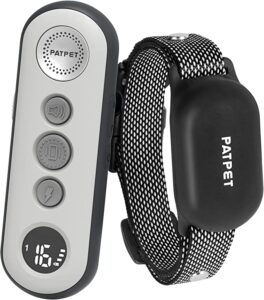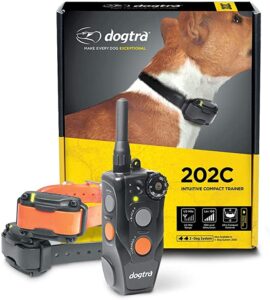Huskies are popular for a reason. They are loyal, friendly, and absolutely charming, especially when they vocalize. Huskies are playful, and brimming with energy, making them excellent for big households and active owners. However, these great traits are also often the cause of problems such as excessive barking, running away from their boundaries, and being overly physical with visitors.
Like all dogs, they can be trained, even with a bag of treats. However, training requires a lot of effort and consistency, and unless you’re willing to put all that work in, a bag of treats can only get you so far. This is why people use training tools like the humble plastic clicker to sophisticated electric shock collars.
Shock collars, however, have quite a bad rep, but there’s a reason why professional trainers still use them. If you’re looking for a shock collar for huskies, we’ll show you 5 great collars you can use on your Husky, and help shed some light on the reason why electric collars are still widely used today, even by dog owners.






- Pros
- Great Value for its Price
- Built-in Anti-Bark Collar
- 3/4 Mile Range
- Pair up to 2 Additional Collars (3 Total)
- Cons
- No Standby/Idle Mode
- Not for Dogs 15 Lbs or Smaller
The first kit on our list of the best shock collar for Siberian Husky breeds is a good all-around training device. It can be used for e-collar training, service/work dog training, hunting, and other outdoor activities where you’ll need to signal or locate your dog from afar. It’s also an anti-bark collar with simple but effective programming. A perfect option for beginners and a great pick for experienced trainers.
Most, if not all, electric collars include shock, vibration, and beep for training. This one has above-average shock strength at level 10, and level 1 is gentle enough for more sensitive dogs. The button layout allows you to operate the remote without looking and with some practice, it’s easy to switch levels on the fly. You may need above-average shock strength when training or managing huskies, as they are very hardy dogs.
The high remote range ensures that even if your Husky runs away from you at full sprint, you’ll be able to reach them even 5 whole seconds after they ran off. You may get a lesser range if there are obstacles between the remote and the receiver, but even getting 50% is still more than a 500-yard range.

If you switch to Anti-Bark mode, you won’t be able to use the remote. Instead, the collar will start listening to your dog’s barking. If they bark for more than a few seconds, the reciever will beep. If they keep barking, the reciever will deliver a shock depending on the level you selected, then rest for a minute before listening again.
If you need to manage at least 3 Huskies, you can purchase 2 additional collars separately and pair them to the same remote. There are numbered buttons on the remote that let you easily switch collars. Furthermore, the LED in the receivers will light up when you press their associated buttons, so not only will you have confirmation on which collar is active, but you can also use this to find your dog in the dark. The LED has a strobing effect which makes it much easier to spot.
In terms of endurance, the remote and reciever are made with durable materials and are water-resistant. The remote can withstand any level of rain or even running water from a faucet in case you need to clean it. The reciever can be submerged under 1 meter or so of water for 30 minutes before suffering water damage. This means your dog can happily frolic and swim in a pool or lake without breaking the collar and you can worry more about yourself when you get drenched in the rain with the remote.
In a single 2-hour charge, the batteries can last around 50-60 hours, depending on how often you use their functions. This device does not have any kind of sleep mode or idle mode when not in use, so it will drain the battery as normal. This is to ensure the remote is always responsive on demand instead of needing a press and a second to “wake up.”
Finally, the kit includes 3 pairs of metal prongs with different lengths and a plastic clicker. Since most Huskies have a double coat, it’s likely that you’ll use the 3rd extra-long prong. This ensures that the contact points touch the skin properly and deliver them into the skin without hurting your Husky.
If you use the shorter ones, you may need to tighten the collar a little bit more than normal, which may be less comfortable for them. The plastic clicker is small but incredibly useful in giving quick, consistent signals, so much so that you may not find a professional trainer anywhere that doesn’t use one of these.
Full Features
- Uses Static Shock, Vibration, and Beep
- 10 Adjustable Levels of Stimulation
- 3/4 Mile Range
- Pair up to 2 Additional Collars (3 Total)
- The reciever can be switched to Anti-Bark Mode
- Remote Activated LED Strobe Lights on Reciever
- Waterproof Reciever
- Splashproof Remote Control
- Battery life – 60 hours
- 2-Hour QuickCharge Rechargeable Batteries
- Includes 3 Different Pairs of Metal Prongs
- Includes a Plastic Training Clicker
- Pros
- Long Battery Life
- No-Look Operation Design
- Includes Silicon Prong Caps
- Cons
- Relatively Lower Strength Shock
- Bulky Remote Controller
Finding the best shock collar for a husky means considering all ranges of training collars, including budget picks. This budget-friendly shock collar is ideal if you know that you have a very sensitive Husky. It’s also a good pick if you’re only aiming for outdoor leisure activities and dog training. Despite being a cheaper option, the kit still uses the same shock, vibration, and beep combo. The shock level is also milder, but a dog’s reaction to the shock is mostly subjective, so if you know your dog is a tough and hardy canine, you might need to use the higher levels.
The remote allows you to adjust the strength by 16 levels. There’s a certain advantage to a higher number of levels by making the “power jump” between levels a lot less. It decreases the chances you being in a situation where one level is too weak, but the next level is too strong. (In this happens to you, opt to use the lower level.)
1/2 miles from a decent budget collar is very good. Since radio signals can often be blocked, you’ll likely get less range, but getting a range of 2000 ft is more than respectable. With this range, handling 2 dogs will be easy, and the remote can support those two at the same time. To switch collars, you’ll need to push a switch up and down, it’s quick and you can easily do it with your index finger while holding the remote.
The button layout is made in a way that your thumb can easily reach all buttons despite the bulky size of the remote. Each training button has its symbol embossed so your thumb can identify which button does what. Useful when training as you don’t usually want your dog to see you holding the remote.

The waterproofing is the same as the first one. The remote should not be submerged in water but can resist rain. The reciever can be submerged in a meter or so of water for 30 minutes before getting any potential water damage.
The big pill-shaped remote holds a big battery, giving it higher battery life. If used for short sessions every day, it can last almost a week on a single charge. If you are going to use this to help your Husky manage their bad behavior, then you’ll get a lot in a single 2-hour charge.
Features
- Uses Beep, Vibration, and Shock
- 16 Levels of Shock and Levels of Vibration
- 1/2 Mile or 3000 ft Range
- Remote Supports 2 Receivers
- Splashproof Remote Control
- Waterproof Reciever Collar
- 60-70 Hour Battery Life, Longer on Sleep Mode
- 2-Hour QuickCharge Rechargeable Batteries
- Pros
- Designed for Quick Level Adjustments
- Waterproof Remote and Reciever
- 21 Levels of Stimulation Combined
- Cons
- Not for Sensitive Dogs
- Usage has a slight learning curve
All of SportDog’s “X” series have one thing in common: They are made to be operated and adjusted without looking, and quickly change levels as fast as your reaction times allow you. One unique thing about the remote is the three buttons dedicated to shock, all with different strengths of static stimulation. This is very important if you’re training your Husky in a place with lots of potential distractions. One day they might suddenly see a squirrel or a cat and chase them. You need to be able to catch their attention, and a suddenly strong stimulation on their necks could stop them and save you a lot of trouble.
The dial that controls the shock level only has 7 levels and a Vibrate/Tone “level” Since you also have buttons for Low, Medium, and High shock strength, you technically have 21 levels of static stimulation, and 1 Level of Vibration. It may take a bit of effort for some to properly operate it, especially when you’re not looking at the remote.
A 1/2 Mile is still a very good range. We could say that 1/2 mile is the minimum range a decent shock collar should have. Anything greater is a bonus. The remote can also handle up to 3 receivers so if you’re going to manage three dogs outside, you’ll likely appreciate the long range.
Another thing different about this collar is that it’s built to last. Both devices are waterproof and weatherproof, so if you end up joining your dog as they swim in the lake, the remote will be the least of your worries.
Battery life on average lasts 50 hours. Less if you maximize the use of the collar like pairing with three dogs and doing training sessions back and forth, but even if you run out of charge, it only takes 2 hours to charge it back to full.
Features:
- Three Training Modes: Shock, Vibration, and Beep
- 3 Buttons for Shock w/ diff Intensities
- 21 Total Stimulation Levels
- 1/2 Mile Range
- Supports 3 Receivers
- Waterproof Reciever and Remote Control
- Battery life – 60-70 hours
- 2-Hour QuickCharge Rechargeable Batteries
- Pros
- Wide Shock Intensity Range (1-99 Levels)
- Up to 1 Mile Range
- Remote Floats on Water
- Cons
- Can't Change Levels Quickly
- Some button combinations require practice
This is also one of the more popular training e-collars for professional use. They advertised it to have a weaker and more “blunt” shock. It’s not clear how this works, so let’s assume the kit has less shock strength.
Some trainers and pet owners need a way to quickly raise their stimulation level. This is to get a distracted dog’s attention. This is especially important for dogs with high prey drive like Huskies. If you’re working in an open space, your husky might spot a running squirrel and drop everything to go for the hunt.
Since this remote has a dial, it’s not exactly easy to flick the dial to a specific level. To solve this, the remote has a shock boost button that triggers a shock that’s up to 60 levels stronger. The boost button can go past level 100, maxing out at level 160. This may make up for the supposed “blunt” shock this collar has if you’re dealing with more stubborn dogs.
Max distance is an option here. All of the models have similar features with only the range and amount of dogs supported. It will go as low as 1/3 mile and as high as 1 mile and the remote handles as many as 2 dogs at the same time.

The remote has decent water resistance and is technically waterproof. The remote is designed to float, making it very easy to recover the remote when it falls into a lake, pond, or pool. The reciever is waterproof, like all the receivers in this list, and all modern shock collars in general.
The battery levels are the same too, lasting an average of 50-60 hours depending on usage. Since the device has idle mode or sleep mode, it will last significantly longer when left on, but not in use. Still, it’s better to turn the devices off when not in use.
Features:
- Three Training Modes: Shock, Vibration, and Beep.
- 100 Levels of Shock via Rheostat
- Up to 1 Mile Range Depending on Model
- Up to 2 Supported Collars per Remote
- Water Resistant Remote Controller
- Remote Floats on Water
- Waterproof Reciever
- 50-60 Hours of Battery Life
- 2-Hour Quick Charge Batteries
- Pros
- One Hand Operation
- Compact Reciever Device
- Wide Shock Intensity Range (1-99 Levels)
- Size: Ranges from 22 inches to 48 inches in length
- Cons
- Less Precise Level Adjustment
- Some Practice Required to Use
The last on the list of our best shock collar for a husky is another popular brand. It’s worth noting that a bit of that price is the weight of the brand and the support behind it, but that weight also guarantees quality. We picked this model because it has the best balance of price-to-feature ratio and has slightly better usability than the other collars, albeit you can’t quickly switch the levels to your precise liking.
The dial offers you 100 levels of shock. It does so using a rheostat you can quickly adjust using your thumb instead of turning with your index and thumb. The other problem is since there’s no LCD display, you’ll have to count on muscle memory to adjust it. Eventually, you can learn to adjust the level by estimation instead of looking at the levels.
With one-handed operation in mind, the button layout and compact remote are made so you can activate the shock buttons with your index finger and middle finger, then activate the vibrate and beep using your thumb.
The remote has a 600-700 yards range or about 1/2 miles. It’s more than enough for training, even for field training. You’ll get the max range when you are in an open space, and even if there’s a brick wall between you and your dog, you’ll still get about 200-300 yards which can reach farther than you shouting commands.
The battery life is still the same standard 50-60 average hours long and can be charged back to full in 2-3 hours. When in standby mode, it can last for up to a week, but it’s always better to turn the devices off when not in use.
Features:
- Uses Shock, Beep, and Vibration Mode
- 100 Levels of Shock
- 1/2 Mile Range
- Supports 2 Reciever Collars
- Waterproof Remote Control and Reciever
- 50-60 Hours of Battery Life
- 2-Hour Quick Charge Batteries
Safety Tips
Using the right dog shock collar for a husky is just a third of the process. The other two are the training process and safety processes. The training process requires practice and can be done through enough homework and some trial and error.
Safety, however, is something any trainer should know by heart on the get-go, so we’ll give you the most important safety tips for shock collar usage to ensure long and effective use of the collar.
1. Do not use the collar on aggressive dogs.
Unless you know what you’re doing, do not use shock training collars to help manage your dog’s aggression, even if it’s the unwanted behavior you need to manage. If your dog is aggressive due to unaddressed anxiety, it might find the shocking feature too much and become more aggressive.
Address sources of aggression first like figuring out when they show the aggression and finding safe ways to expose them to these triggers until they are desensitized. If you have something like Leash Aggression, you may need to use Positive Reinforcement like distracting them with treats until their aggression has lessened. Finally, have a vet check them in case they have unseen pain problems or discomfort that’s causing the aggression.
This applies to any type of collars like a spray collar, a fence e-collar, or even manual ones like a prong collar.
2. Find and use the lowest level your dog will respond to.
Huskies can be erratic. Some of them are total lightweights that will cave from the slightest tap, or are utterly stubborn and will make it their life purpose to annoy you. The best way to train them with shock is to find the level that they will minimally, but visibly react to. This way you’ll lessen the anxiety your dog gets from the stimulation, but they will still want to turn the sensation off because it’s annoying.
The process is as follows: Place the collar on your dog properly, set the remote to the lowest levels of correction, then activate the shock while observing your dog carefully. If you see them slightly react to it, like turning their head, or suddenly stopping panting, or slightly flinching, then stick to this level.
If they don’t react, raise the remote to the next level and try again. Remember this level and stick to it during training. It’s fine to use a higher level if you need to catch their attention when they are heavily distracted or are in relative danger.
3. Always test the receiver functions once a week or more frequently.
These devices are still very complex and it’s not uncommon for some of them to start malfunctioning. That’s why the devices always have testers on them. With this, you can always test the shock functions. The tester has a small LED that lights up when both prongs are delivering electricity.
It grows brighter the stronger the shock. Testing them as often as you can detect defects before they cause problems with your dog. Some of the people who experience problems like their shock collar not working on husky training tend to either have problems with the training process, or their devices.
4. Learn the proper training method
Finally, the best safety tip is learning how to use the device. Read the manual and other articles widely available on the web to learn about training. At first, it may sound daunting, but once you understand the terms and the skeletal process of the training, such as the mix of positive and negative reinforcement, all that’s left is to practice. It’s fine to make small mistakes here and there when training. Even professional trainers must understand their canine student’s behaviors before training. Once you get the hang of the timing and the process, it’s then a matter of devising efficient training modes such as breaking a certain behavior down into smaller behaviors and training each of those behaviors. All the while, as long as your dog is enjoying the training, it will eventually learn and adapt, making the training process a little bit easier every time.
Conclusion
Our domesticated furry friends are almost fully adapted to our ways. As such, it’s up to us pet parents to help them live a better life with us. Though they sometimes do things to serve us, it’s ultimately us that serves them and helps them survive.
It’s up to us to make sure they live the best life they can, and as long as we treat them with respect and understand their limits, any training process will always be for the better, even if it only results in them enjoying your company.
Last update on 2024-04-28 at 13:51 / Affiliate links / Images from Amazon Product Advertising API









